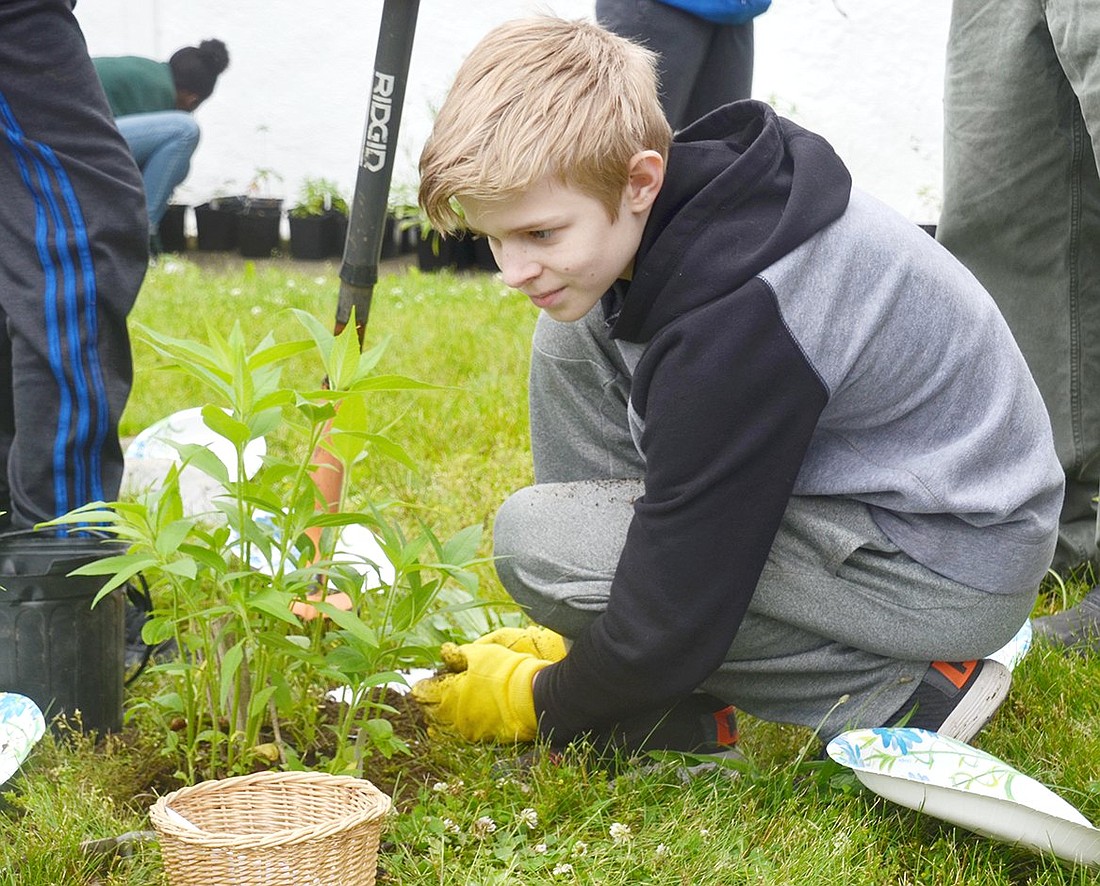Historical horticulture
June 6, 2019 at 7:30 a.m.
There are endless amounts of research detailing the ways gardening can positively impact young minds, according to Port Chester resident Kikki Short.
Some of those impacts can be easily assumed—it helps students with focus and it’s a relaxing process that enables physical, outdoor activity. However, some Port Chester teens recently reaped a less conventional benefit: practicing gardening to enhance their understanding of history.
Last summer, Port Chester High School students Molly Brakewood and Peter Manos undertook passion projects to restore the 1700s-era Bush-Lyon Homestead in Lyon Park and catalog the artifacts within. Part of Brakewood’s project also involved reestablishing the relatively dormant Port Chester Historical Society, which has been regularly meeting at the homestead ever since.
Last week, the revitalized Historical Society started to delve into student-oriented educational endeavors. With a dual purpose of beautifying the antique home and getting kids involved with their local landmark, Short partnered with Port Chester Middle School teachers to plant a colonial-era garden with some pupils on Thursday, May 30.
“We wanted to put something in place where right off the bat we could have students involved with planting. Understanding the importance of plants in the past, where everything you needed in the world had to come from natural objects,” said Short, a Historical Society member. “Learning by doing; it seemed like a great opportunity.”
Because Short has an inherent interest in gardening, she attended a Green School Conference—which had nothing to do with history but moreover lectured on using horticulture to instill sustainability and zero waste values in students.
It struck her, Short said, that those premises are in sync with an 18th century lifestyle, and she realized they could tie in current issues and curriculum focuses with an historical perspective. She got in touch with Allison Silverman, the family consumer science teacher who runs the middle school Giving Garden, who in turn spoke to social studies teachers to devise a fieldtrip.
Last Thursday, 25 middle schoolers from all grade levels visited the Bush-Lyon Homestead. After touring the house, Short introduced historical, native plants to them and taught them how to garden before each student rooted one for themselves.
“It’s great for them to come here just to see the house and know that in their community there’s a historical home like this,” Silverman explained. “It’s not just an opportunity to learn about the history of the town they grew up in, but because this house was recently restored by a project through high school students, it shows them that if they’re interested in something and want to do it, they can have an impact.”
The middle school teachers were tasked to selected 25 students who both appreciated history and were interested in gardening. Specific criteria, but ultimately easy to satisfy with students like Sophia Ortiz-Heaney.
Ortiz-Heaney loves to garden—she does it regularly with her father at home. Beyond that, history is her favorite subject because it’s critical to understand mistakes of the past to avoid them in the future, she said.
“This experience has been so intriguing and inspiring. It’s really nice to learn our history and it’s great to be a part of bringing it back,” the eighth-grader said. “Planting native plants that will bring back the time period will hopefully help people see what it would be like in that perspective.”
Students planted a variety of flora that were enjoyed before 1775, such as Wild Bergamot, Jerusalem Artichokes and Tickseeds, and discovered both their common and scientific names. Before students got their hands dirty, Short gave brief lessons about what each plant was used for—explaining how colonists and Native Americans often used the same species medicinally, for food or other material functions.
Everything came from natural objects then, Short said, as opposed to plastic. Tying it into the curriculum, she said that’s why the culture naturally facilitated no waste and sustainable practices.
“This is a really important activity to show them native plants that actually grew in the region, the real original plants that were here,” Silverman said. “Hopefully these gardens will grow to really show a rich history of agriculture, along with the cool history of the house.”
Before the kids left, they painted the common and scientific name of the plants on rocks which were placed throughout the garden so others can identify each species, too. Then, Short made digital recordings of several students explaining the function of each plant and linked each video with a QR code. Now, Bush-Lyon Homestead visitors can peruse the garden and scan codes with their phones for more information.
Ortiz-Heaney said she appreciated the fieldtrip because it provided an insight into how people used to think, which is exactly why Short thought the experience would be valuable.
“It’s one thing to look and learn from a garden, but when you’ve never planted anything, you don’t know what that effort is. This program allows them to carry a much greater understanding of what it takes to grow your own food, or how to figure something out from the natural world when you have a cut,” Short emphasized. “When you have that hands-on experience, you have a greater understanding of your own world, and quite frankly, your own past.”
The middle school has the Giving Garden, John F. Kennedy School has a greenhouse and Park Avenue School is working toward establishing a garden, Short said. Therefore, ideally, she would like to see a similar program extended to all the elementary schools and the middle school in the future. Especially since most could facilitate it on their property.
After all, Thursday’s fieldtrip made evident that student ambition is there.
“The kids did a great job. They seemed really interested in learning about the site itself and talking about where different foods come from,” Short said. “In this electronic age we live in, it’s a great thing that kids are still excited to dig in the dirt.”




Comments:
You must login to comment.